AUDI A8 2012 Owners Manual
Manufacturer: AUDI, Model Year: 2012, Model line: A8, Model: AUDI A8 2012Pages: 300, PDF Size: 75.06 MB
Page 211 of 300
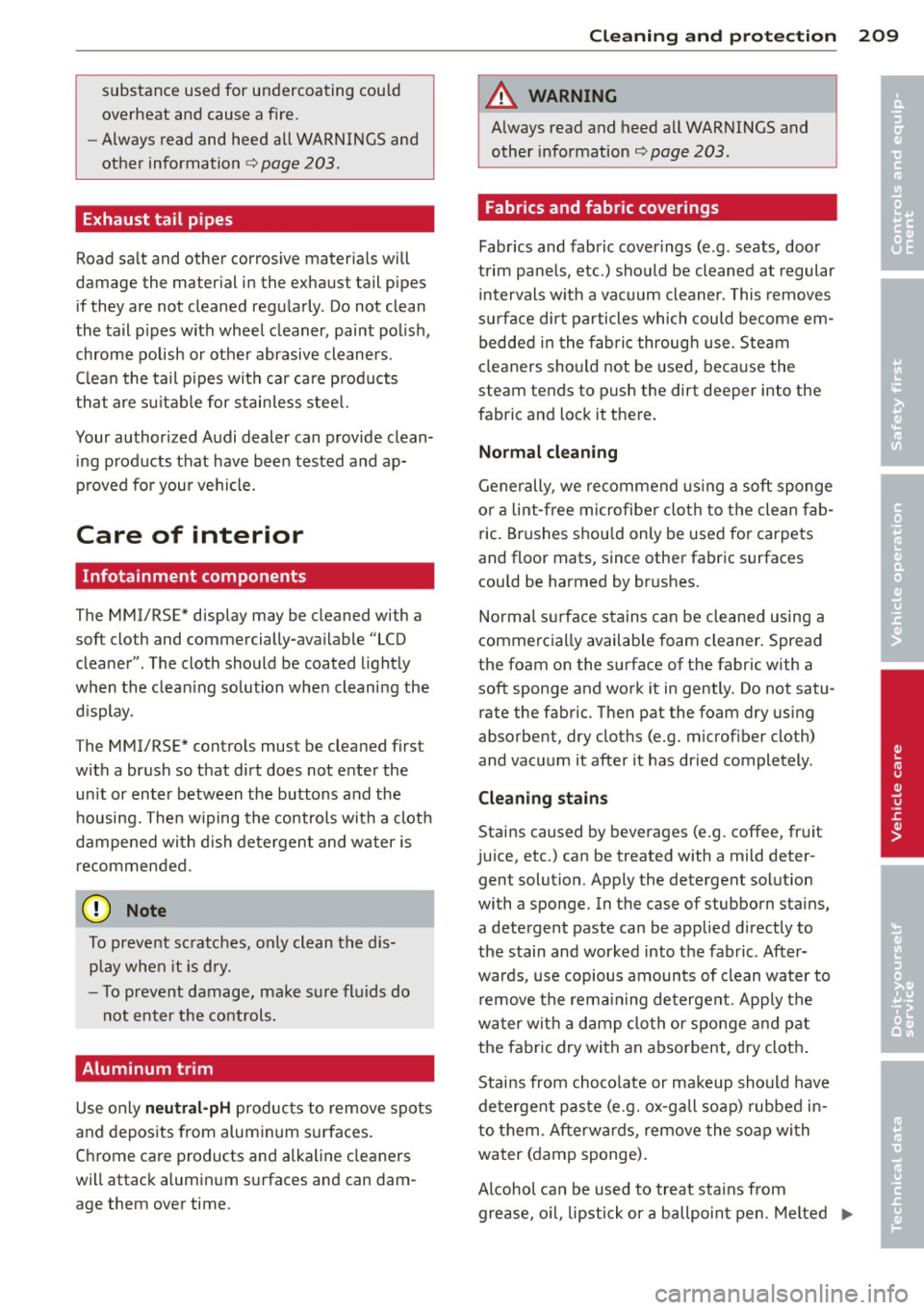
substance use d for u ndercoating cou ld
overheat an d cause a fire.
- Always read and heed all WARNINGS and
other information
¢ page 203.
Exhaust tail pipes
Road sa lt and other corros ive materials will
damage the mater ial in the exhaust tail p ipes
if they are not cleaned regu larly . Do not clean
the ta il p ipes with wheel cleaner, paint polish,
chrome polish or othe r abrasive cleaners .
C lean the tail p ipes with ca r ca re products
that are s uita ble for stain less stee l.
Your authorized Audi dealer can provide clean i ng p rod ucts that have been tested and ap
p roved fo r your vehicle.
Care of interior
Infotainment components
The MMI/RSE* disp lay may be cleaned with a
soft cloth and commercially-ava ilable "LCD
cleaner" . The cloth should be coated light ly
when the clean ing solution when cleani ng the
d isplay.
The MMI/RSE* contro ls must be cleaned first
with a brush so that dirt does not enter the
un it o r enter between the buttons and the
h ousing. Then w iping the controls with a clot h
dampened wi th d ish dete rgent and water is
recommended.
(D Note
To preve nt sc ratches, only clean the dis
p lay when it is d ry.
- To p reven t damage, ma ke s ure fluids do
not enter the cont rols.
Aluminum trim
Use only neutral-pH produc ts to remove spots
and depos its from alum in um s urfaces.
C hr ome ca re products and alkaline cleaners
will attack alum in um s urfaces and can dam
age them over time.
Cleaning and protec tion 209
A WARNING
A lways read and heed all WARNINGS and
other information
¢page 203.
Fabrics and fabric coverings
Fabr ics and fabric cover ings (e.g. seats, door
trim pa ne ls, etc.) shou ld be cleaned at regular
i n tervals w it h a vac uum cleaner. This removes
s ur face di rt particles which cou ld become em
bedded in the fabri c throug h use. Ste am
cleaners sho uld not be used, beca use the
steam tends to p ush the dirt deeper into the
fabric and lock it there .
Normal cleaning
Generally, we recommend using a soft sponge
o r a lint -free microfibe r clo th to the clean fab
ric. Br ushes shou ld only be used for carpets
and floor mats, since other fabric surfaces
could be harmed by br ushes.
Norma l su rface s tains c an be cleaned using a
commerc ially availab le foam cleaner . Spread
the foam on the s urface of t he fabric with a
soft sponge and work it in gently. Do not satu
rate the fabric. T hen pat the foam dry us ing
absorbe nt, dry cloths (e.g. m icrofiber cloth)
and vacuum it after it has dried completely.
Cleaning stains
Stains caused by beverages (e .g. coffee, fr uit
juice, etc.) can be treated with a mild deter
gent solution. Apply the detergent sol ution
with a spo nge. In the case of stubborn stains,
a detergent paste can be applied directly to
the stain and worked into the fabric. After
wards, use copious amounts of clean water to
remove the rem aining de terge nt. Apply the
w at er wit h a d am p clot h or sponge a nd pat
the fabric dry with an abso rbent, dry clot h.
Stains from choco late or makeup should have
de terge nt pa ste (e.g. o x-gall soa p) rubbed i n
to them. Afterwa rds, remove the soap wi th
wa ter (damp sponge) .
Alcohol can be used to treat stains from grease, o il , lipstic k or a ballpoin t pen. M elted ..,_ •
•
Page 212 of 300
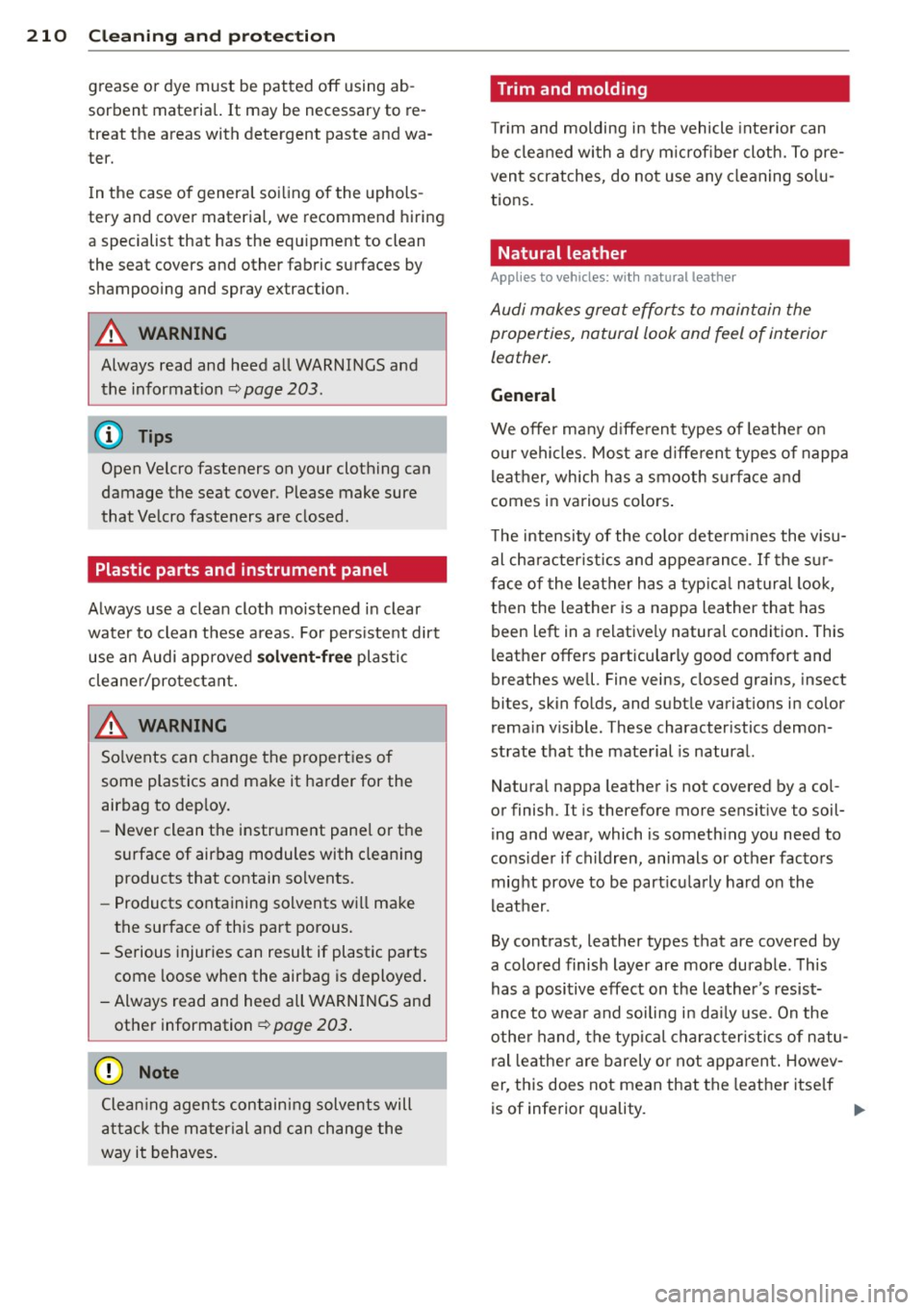
210 Cleaning and protec tio n
grease or dye must be patted off using ab
sorbent materia l. It may be necessary to re
treat the areas with detergent paste and wa
te r.
I n the case of general soi ling of the uphols
tery and cover material, we recommend hiring
a specialist that has the equ ipment to clean
the seat cove rs and other fabric surfaces by
shampooing and spray ex traction.
A WARNING
Always read and heed all WARNINGS and
the information
~ page 203.
(D Tips
Open Velcro fasteners on your clothing can
damage the seat cover. Please make sure
that Velcro fasteners are closed.
Plastic parts and instrument panel
Always use a clean cloth moistened in clear
water to clean these areas. For pers istent dirt
use an Audi approved
s ol ve nt-fr ee plastic
cleane r/protectant.
A WARNING
So lvents can change the properties of
some plastics and make it harder for the
airbag to dep loy.
- Never clean the instr ument pane l or the
surface of airbag modules with cleaning
products that contain solvents .
- Products containing solvents wi ll make
the surface of th is part porous.
- Serious injuries can result if plastic parts
come loose when the airbag is deployed .
- Always read and heed all WARN INGS and
other information ~
page 203.
0 Note
Cleaning agents con taining solvents will
at tac k t he mater ial and can change the
way it behaves .
Trim and molding
Trim and molding in the vehicle interior can
be cleaned with a dry m icrofiber cloth. To pre
vent scratches, do not use any cleaning so lu
tions.
Natural leather
Appl ies to vehicles: with natural leather
Audi makes great efforts to maintain the
properties, natural look and feel of interior
leather .
General
We offer many d iffe rent types of leather o n
ou r vehicles. Most a re d ifferent types of nappa
l eather, which has a smooth s urface and
comes in various colors .
T he intensity of the co lor dete rm ines the visu
al characterist ics and appea rance . If the su r
face of the leather has a typ ica l natural look ,
then the leather is a nappa lea ther that has
been left in a relative ly natural condition . This
l eather offers particularly good comfort and
breathes we ll. Fine veins, closed grains, insect
bites, skin folds, and subtle variations in color
rema in v is ible. These character istics demon
strate that the material is natural.
Natura l nappa leather is not covered by a co l
or finish. It is therefore more sensitive to soil
i ng and wear, which is someth ing you need to
consider if children, animals or other factors
might prove to be part icu la rly ha rd o n the
leather .
By contrast, leather types that are covered by
a colo red finish layer are more durable. This
has a positive effect on the leather 's resist
ance to wear and soiling i n dai ly use . On the
other hand, the typica l char acteristics of natu
ral leathe r are barely or not appa rent. Howev
er, this does not mean that the leather itse lf
is of infe rior quality.
Page 213 of 300

Care and handling
Because of the exclusive nature of the types of
leather that Audi uses and their unique prop
erties (such as sensitivity to oils, grease, soi l
ing, etc.), you will need to be somewhat care
fu l with these leathers, and a certain type of
care is required. For examp le, dark cloth ing
materials can d iscolor leather seats (especial
ly if such cloth ing is damp and was not dyed
correctly) . Dust and d irt part icles in pores,
fo lds, and seams can have a n ab ras ive effect
and can damage the leathe r sur face as well as
weaken seams.
The leather should be cleaned regularly as
n eeded . After having been used for a re lative ly
long t ime, yo ur leather seats will acqui re a
rich aged finish. This is a characteristic of nat
ura l leather and a sign o f true quality .
I n o rder to maintain the va lue of th is natura l
p rod uct over the life of yo ur vehicle, you
should follow the recommendations below :
(D Note
-To keep you r leather from bleach ing out,
do not a llow i t to be exposed to bright
s unli ght for long periods of time. If you
have to leave the vehicle parked o utside
for long periods, cover the leather to protect it from d irect exposure to sun
li ght.
- Sharp objects on clothing, such as zip
pers, rivets or sharp pieces on be lts can
l eave permanent scratches or scrape
marks on the surface of the leather.
(D} Tips
- After each time you clean the leather and
at regular interva ls, use a leather preser
vat ive creme that conta ins UV-blockers
and that works into the leather . This
creme w ill nou rish and moistur ize the
l eather, helping it to b reath e and stay
supple. It al so helps to b uild up a pro tec
tive coat ing o n the s urface.
- Clean the leathe r every 2 -3 months,
and clean a ny a reas that get soiled .
Cleaning and protec tion 21 1
- Remove fresh ma rks made by ballpo int
pens, ink, lipstick, shoe po lish, etc. as
soon as poss ible .
- Preserve the color of the leather as need
ed by using a specia l co lored leather care
creme to touch up areas of uneven color.
Cleaning and caring for leather
upholstery and trim
App lies to vehicles: with natural leather
Natural leather requires special care and a t
tention .
Normal clean ing
.. Clean soiled areas with a slightly moistened
cotton or woolen cloth .
More stubborn dirt
.,. More s tubborn di rt ca n be removed using a
cloth sa turated wi th a mild soap sol ution (2
tablespoons mild liq ui d soap) .
.. Never a llow the soap so lution to saturate
the leather, and make certain that no water
s oak s in to the seam s.
.,. Wipe off the soap so lu tion with a soft, d ry
cloth .
Cleaning spots
.. Remove fresh wate r-based spots (such as
coffee, tea, juices, blood) with an absorbent
cloth or paper towel.
.,. Remove fresh
grease or oil -based spots
(such as butter , mayonnaise, chocolate) with
an absorbent clot h or paper towel, or use
the cleaner from the leather care kit if the
spot has no t yet penetrated into t he surface
of the leather .
.,. Use an oil/grease dissolving spray, i f
oil/
grease spot s have d ried on.
.. Remove specific kinds of spots (ballpoint
pen, fe lt marker, fingerna il polish, water
based pa int, shoe po lish, etc.) with a spot
remover specifically formu lated for lea ther.
Leather care
.. Every half yea r use an approved leather care
product (available from your Audi dea ler) to
care for the leather . .,.
•
•
Page 214 of 300
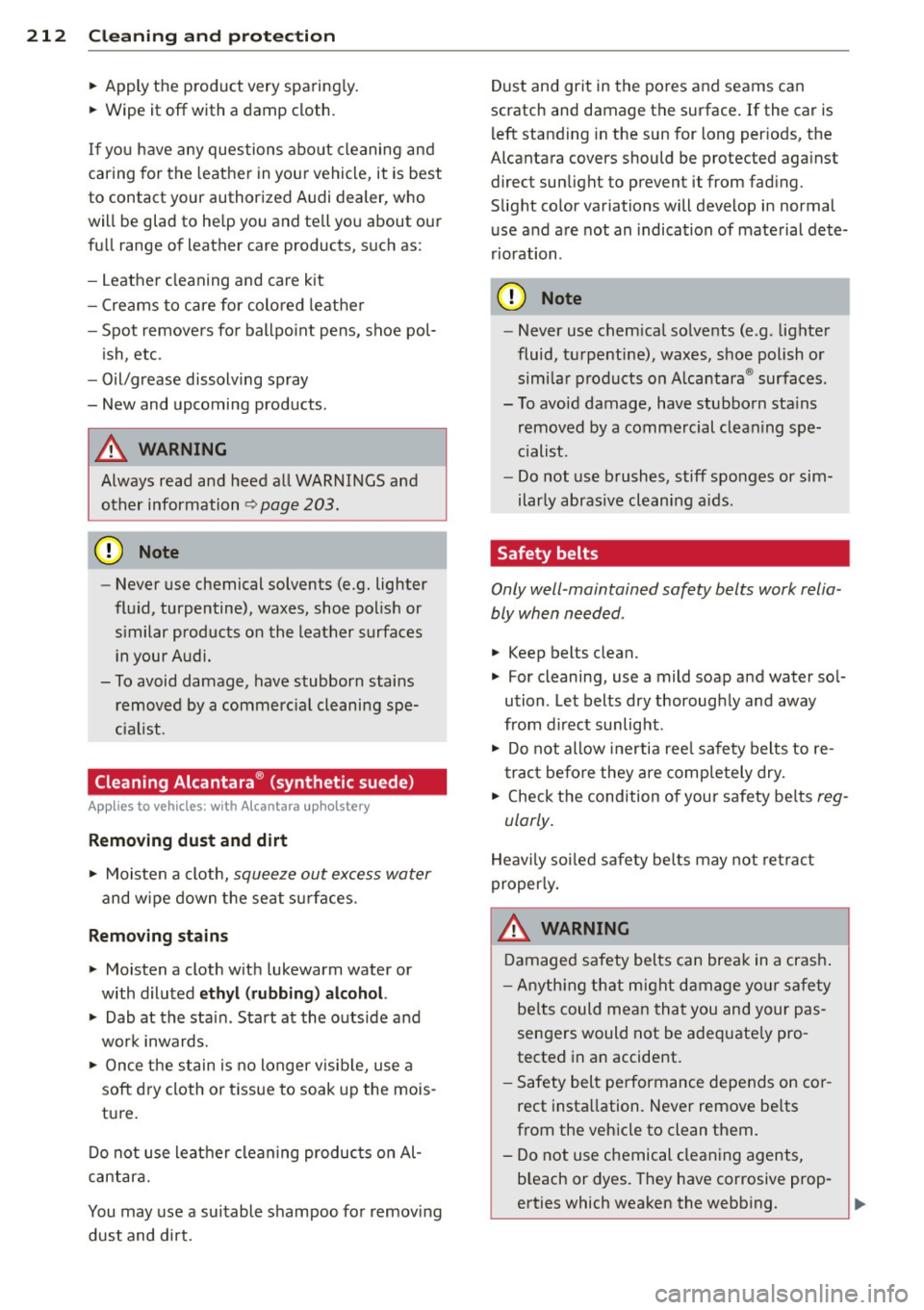
212 Cleaning and protec tio n
• Apply the p roduct very sparing ly.
• Wipe it off with a damp cloth.
I f yo u have any questions about cleaning and
caring for the leather in your vehicle, it is best
to contact your authorized Audi dealer, who
will be glad to he lp you and te ll you about our
fu ll range of leather care products, such as:
- Leathe r cleaning and care kit
- Creams to care for colo red leather
- Spot removers for ballpo int pens, shoe po l-
ish, etc.
- Oil/grease dissolving spray
- New and upcoming products .
A WARNING ,_
Always read and heed all WARNINGS and
other information
~ page 203.
0 Note
- Never use chemical solvents (e.g. lighter
fluid, turpentine), waxes, shoe polish or
s imilar products on the leather surfaces
i n your Audi.
- To avoid damage, have stubborn stai ns
r emoved by a commerc ial cleaning spe
cia list.
Cleaning Alcantara ® (synthetic suede)
Applies to vehicles: with Alcantara upholstery
Removing dust and dirt
• Moisten a cloth, squeeze out excess water
and wipe down the seat su rfaces.
Removing stains
• Moisten a cloth w ith lukewarm water or
with diluted
ethyl (rubbing) alcoho l.
• Dab at the stain. Start at the outside and
work inwards.
• Once the stain is no longer visib le, use a
soft d ry cloth or tissue to soak up the mois
ture .
Do not use leather cleaning products on Al
cantara.
You may use a suitable shampoo for removing
dust and dirt. D
ust and grit in the po res and seams can
scratch and damage the surface. If the car is
l eft standing in the sun for long per iods, the
Alcantara covers should be protected aga inst
direct sunlight to prevent it from fad ing.
Slight co lor variations will develop in normal
use and are not an indication of material dete
rioration .
(D Note
-Never use chemical so lvents (e.g. lighter
fluid, turpentine), waxes, shoe polish or
simi la r products on A lca ntara® surfaces.
- To avoid damage, have stubborn sta ins
removed by a commercial clean ing spe
cialist.
- Do not use brushes, stiff sponges or sim
ilarly abrasive cleaning a ids.
Safety belts
Only well-maintained safety belts work relia
bly when needed .
.,. Keep belts clean.
• For cleaning, use a mild soap a nd water so l
ution. Let belts dry thoroug hly and away
from d irect sunlight .
• Do not allow inertia ree l safety belts to re
t ract before they are completely dry.
• Check the condition of you r safety be lts
reg
ularly .
Heavi ly so iled safety be lts may not ret ra ct
properly.
A WARNING ~
Damaged safety belts can break in a crash .
- Anyth ing th at might damage yo ur sa fety
be lts could mean that you and your pas
sengers would not be adeq uate ly pro
tected in an accident.
- Safety belt performance depends on co r
rect insta llation. Never remove be lts
from the vehicle to clean them.
- Do not use chemical cleaning agents, bleach or dyes. They have corrosive prop
erties which weaken the webb ing.
Page 215 of 300

-Wh en cl eaning your safety belts, inspect
them for damage. If you discover dam
age, see your Audi dealer .
- Always read and heed all WARNINGS and
other information ¢
page 203.
Cooler
Applies to veh icles: with coole r
A layer of ic e or frost in th e cool er interfer es
with its cooling performanc e.
Cleaning
The refr igerator sho uld be cleaned reg ula rly .
.,. Wash the cooler w ith lukewarm water a nd a
mild cleaning so lution, if necessary .
.,. The n w ipe the coole r dry.
.. Dust and dir t will acc umu late near the ven
t il ation openings in the luggage compar t
me nt due to normal coole r usage. This
sho uld be cleaned reg ularly.
Defrosting
.,. Switc h the coo ler off ¢ page 72.
.. Remove any food or beverages and al low
the coole r to defrost with the door open .
.. Wipe the inside of the coo ler dry and clean
the cooler , if necessary .
D efrost the cooler if yo u will no t be using it
for ex tended periods of time .
Q) Note
-Do no t try to speed up the defrosting
p rocess by applying heat.
- To red uce the risk of pe rsonal injury or
dam age to the refrige rator,
- do not use any abrasive cleaners, sol
vents, wax, aggressive cleaning solu
tions , so lutions with strong fragrances,
etc.,
- do not clean the coo ler with cleaning
tools such as stee l wool.
l ) U se o nly the co rr ec t cl ean in g so lu tio ns. Ne ve r use ga s
o line or d ie sel fuel.
Cleaning and protec tion 213
Engine compartment
Be especially careful when cleaning the en
gine compartment.
Always switch off the ignit ion before clean
ing the engine
¢ .& .
Plenum panel
Remove leaves from the plenum panel in front
of the windshield under the engin e compart
ment . This prevents the water drain holes
from becoming b locked , and it preve nts de
bris from entering the vehicle interio r through
the heat ing and ventilat ion ducts .
Corrosion protection
The eng in e compartm ent and transmission
have been corrosion-protected at the facto ry .
Good anti -corrosion treatment is very impor
tant , partic ularly in the w inte r.
If the vehicle
is frequently d riven on salt treated roads, th e
entire engine compartment and p lenum panel
shou ld be thoroughly cleaned at the end of
winter a nd retreated to p revent salt damage .
At the same time, the unde rside of the vehicle
shou ld be washed as well.
If the engine compar tment is cleaned at any
time with grease remov ing solutions
1> , or if
you have the engine washed, the ant i-corro
s io n treatment is almost always removed as
well.
It i s therefo re essentia l to have a long
lasti ng cor rosion pro tect ion rea pplied to all
s u rfaces , seams, joints and components in the
engine compartment .
A WARNING
Be aware: The engine com partment of any
motor veh icle is a potentially hazardous
area.
- Before work ing in the engine compart
ment, be sure to read the information
¢ page 219 .
•
•
Page 216 of 300
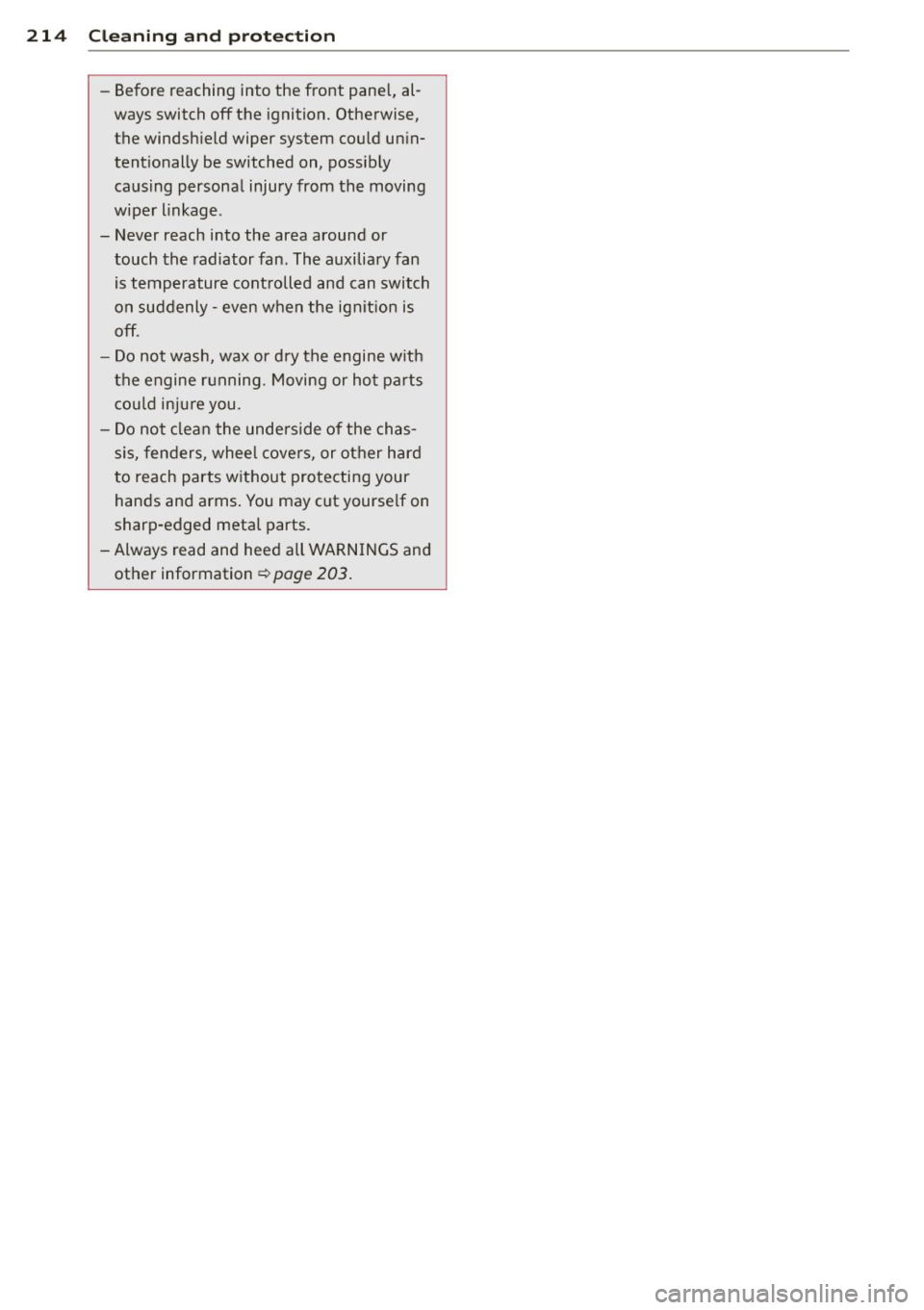
214 Cleaning and protec tio n
- Before reaching into the front pane l, al
ways switch off the ignition. Otherwise,
the windshield wiper system could un in
tent ionally be switched on, possib ly
causing personal injury from the moving
wiper linkage .
- Never reach into the area around or
touch the radiator fan. The auxiliary fan is temperature controlled and can switch
on suddenly- even when the ignit ion is
off.
- Do not wash, wax or d ry the engine w ith
the engine running. Moving or ho t pa rts
cou ld inju re you .
- Do not clean the underside of the chas
sis, fenders , wheel cove rs, or other hard
to reach parts w ithout protecting your
hands and arms . You may cut yourse lf on
sharp-edged metal parts.
- Always read and heed all WARNINGS and other information
c::> page 203 .
Page 217 of 300

Fuel supply and filling
your f uel tank
Gasoline
Fuel supply
Using the right fuel helps keep the environ
ment clean and prevents engine damage.
Fuel recommendation
The fuel recommended for you r vehicle is un
leaded premium
g rade gasolin e. See also
¢ page 278, Data. Audi recommends usi ng
TO P TI ER Deterge nt Gaso line wi th a minim um
oc ta ne ra ti ng of 9 1 AK I (9 5 RON). For more
in fo rmation on TO P TI ER De tergent Gaso line,
p lease go to the official website (www.toptier
gas.com).
The re commended g asoline octane r ating for
your engine can a lso be fo und o n a label loca t
e d on the ins ide of the fuel filler flap . This rat
ing may be specif ied as A KI or RO N.
Your veh icle m ay also be oper ated using un
l e aded regular gasoline with a minimum oc
tane rating of 87 AKI/91 RO N. However, using
87 AKI/9 1 RO N octa ne f ue l w ill sli ghtly re
d uce eng ine perfo rmance .
Use unleaded gasoline only. Unleaded gaso
line is available th rougho ut the USA, Canada,
a nd in most E uropean cou ntries . We recom
mend that you do not ta ke yo ur vehicle to
areas or count ries where unleaded gasoline
may not be ava ilable.
F or mo re informat io n on refue ling your ve hi
cle, see ¢
page 216.
Octane rating
Octane r ati ng in dicates a ga so line's abili ty to
r es ist engine damaging "knoc k" ca used by
p remature ign ition and detonation. Therefore,
buy ing the correct grade of gaso line is very
i mportant to help prevent possible engine
damage and a loss of engine performance.
Gasoline most common ly used in the Unite d
States and Canada has the followin g octane
Fuel supply and filling your fuel tank 215
ra tings that can usu a lly be found on the fi ller
p ump :
- Premium Gr ade: 9 1 -9 6 AKI
- Regular Grade : 87 -90 AKI
Explanation of the abbreviations:
AKI = Anti K nock In d ex = (R+M )/2 = (RO N
+M ON)/2
RON= Resear ch O ctane Num ber
MO N= Motor Octane Number.
(D Note
- Do not use a ny fue l w it h octane rat ings
lower than 87 A KI or 9 1 RO N othe rwise
e xpensive engi ne damage w ill occur.
- Do
not use leaded gasoli ne . The use of
leaded gasolin e w ill severely damage
yo ur vehicl e's cata lytic co nve rter and its
ability to control exh aust em iss ions.
Blended gasoline
U se of gasoline containing alcohol or
MTBE (methyl tertiary butyl ether)
You may use unleaded g asoline blende d with
a lcohol o r MTBE (commonly re fer red to as
oxygenates) if the blende d mixture meets the
fo llow ing criteria:
Blend of gasoline methanol (wood alcohol or
methyl alcohol)
- Anti -kno ck index mus t be 87 A KI or higher.
- Blend must contain no mor e than 3% meth-
anol.
- Blend must co ntain more than 2% co-sol-
vents .
Blend of gasoline and ethanol (grain alcohol
or ethyl alcohol)
- Anti -knoc k index must be 87 A KI or higher.
- Blend must not conta in mo re tha n 10%
ethanol.
Blend of gasoline and MTBE
- Anti -knoc k index must be 87 AKI or higher . ll>-
•
•
Page 218 of 300

216 Fuel supply and filling your fuel tank
-Blend must contain not more than 15%
MTBE.
Seasonally adjusted gasoline
Many gasoline grades are blended to perform
espec ially we ll for winter or summer driv ing.
During seasonal change-over, we suggest that
you fill up at busy gas stat ions where the sea
sonal adjustment is more likely to be made in
time.
(CT) Note
- Methanol fuels which do not meet these
requirements may cause corrosion and
damage to plastic and rubber compo
nents in the fuel system .
- Do not use fuels that fai l to meet the
specified criteria in this chapter.
- If yo u are unable to determine whether
or not a particular fuel blend meets the
specifications, ask your service station or
its fuel sup plier.
- Do not use fuel for which the contents cannot be identified.
- Fuel system damage and performance
problems resulting from the use of fuels
different from those specified are not
the respons ibility of Audi and are not
covered under the New Vehicle or the Emission Control System Warranties.
- If you experience a loss of fuel economy
or driveability and performance prob l ems due to the use of one of these fuel
blends, we recommend that you switch
to unblended fuel.
Gasoline additives
A major concern among many auto manufac
turers is carbon deposit build- up caused by
the type of gasoline you use.
A lthough gasoline grades differ from one
manufacturer to another, they have certain
things in common. All gasoline g rades contain
substances that can cause deposits to co llect
on vital engine parts, such as fuel injectors
and intake valves. Although most gasoline
brands include additives to keep engine and fuel
systems clean, they a re not equally effec
tive .
A udi recommends using TOP TIER Detergent
Gasoline. For more information on TOP TIER
Detergent Gasoline, please go to the official
website (www.toptiergas.com).
After an extended period of using inadequate
f uels, carbon deposit build-ups can rob yo ur
engine of peak performance.
(D Note
'
Damage or malf u nct ion due to poor fuel
quality is not covered by the Aud i New Ve
hicle Limited Warranty.
Fuel tank
Fuel filler neck
The fuel filler neck is located on the right rear
s ide panel behind the fuel filler flap.
If the power locking system should fail, you
can still open the flap manually- for detailed
instructions see
¢page 218.
You can find the fuel tank capacity of your ve
hicle in
Technical Data ¢ page 278.
The label on the inside of the fuel fi ller flap
tells you the correct fue l for your veh icle. For
more information about fuel specifications,
see
¢ page 215.
Your vehicle fuel tank has an on board refuel li ng vapor recovery system. This feature helps
to prevent fuel vapors from escaping from the
tank and polluting the environment while you refuel your vehicle . In order to fill the tank
properly wh ile protecting the environment,
please fo llow this refueling procedure careful
ly.
.8, WARNING
Under normal operating cond itions, never
carry additional fuel containers in your car.
Gas canisters and other containers used to
transport fuel can be dangerous. Such con
tainers, full or empty, may leak and could
cause a fire in a collision. If you must
Page 219 of 300
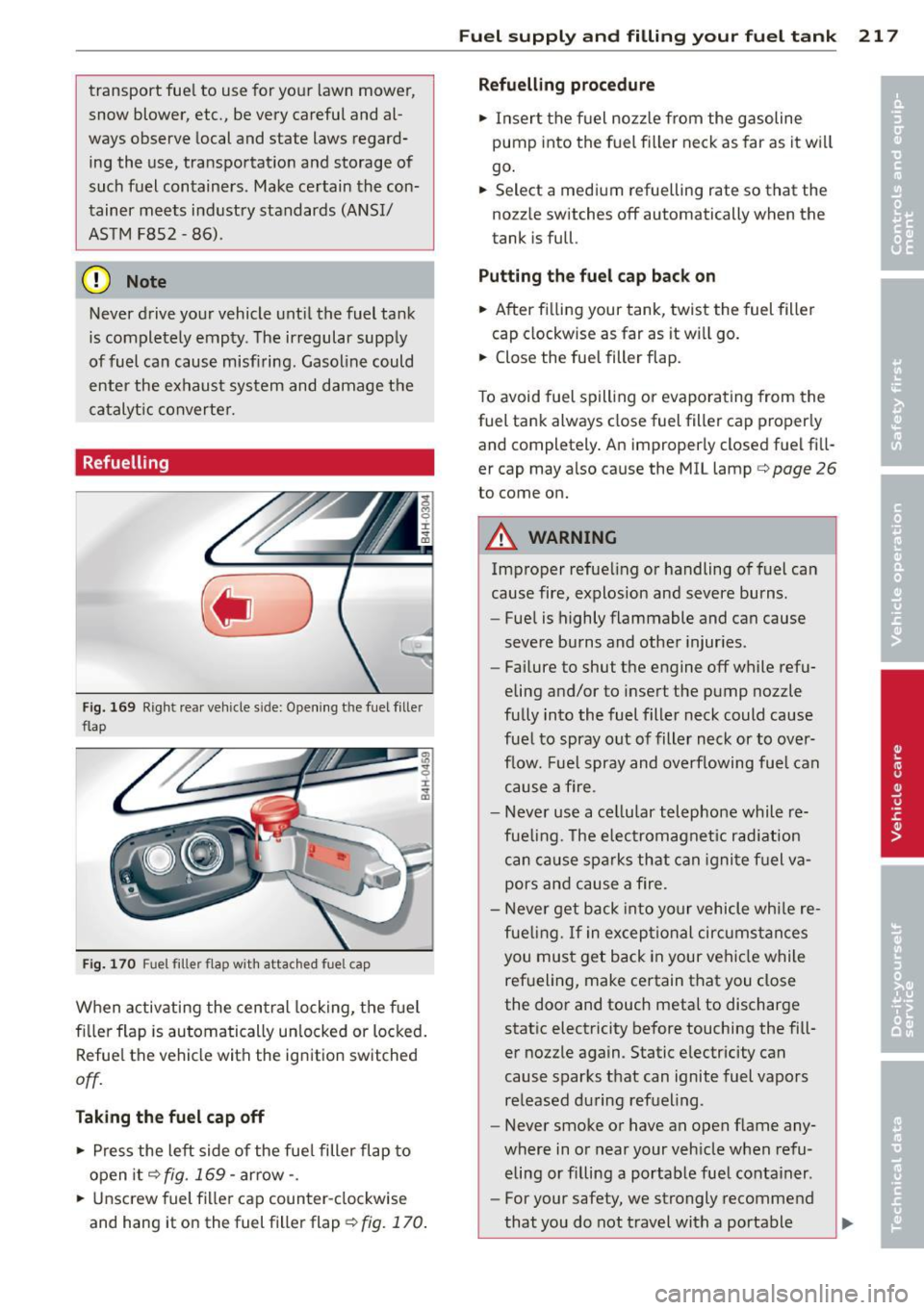
transport fuel to use for your lawn mower,
snow blower, etc., be very careful and al
ways observe local and state laws regard
ing the use, transportation and storage of
such fuel containers. Make certain the con
tainer meets industry standards (ANSI/
ASTM F8S2 -86) .
@ Note
Never drive your vehicle until the fuel tank
is completely empty. The irregular supply
of fuel can cause misfiring. Gasoline could
enter the exhaust system and damage the
catalyt ic converter.
Refuelling
Fig. 169 Right rear vehicle s ide: Opening the fuel filler
flap
Fig. 170 Fuel filler flap with attached fuel cap
When activating the central locking, the fuel
f ill er flap is automatically un locked or locked.
Refuel the vehicle with the ignition switched
off.
Taking the fuel cap off
• Press the left side of the fuel filler flap to
open it¢
fig. 169 -arrow-.
• Unscrew fuel filler cap counter-clockwise
and hang it on the fuel filler flap
~ fig. 170 .
Fuel supply and filling your fuel tank 217
Refuelling procedure
• Insert the fuel nozzle from the gasoline
pump into the fuel filler neck as far as it will
go.
• Select a medium refuelling rate so that the
nozzle switches off automatically when the
tank is full.
Putting the fuel cap back on
• After filling your tank, twist the fuel filler
cap clockwise as far as it will go.
• Close the fuel filler flap.
To avoid fuel spill ing or evaporating from the
fuel tank always close fuel filler cap proper ly
and completely. An improperly closed fuel fill
er cap may also cause the MIL lamp ¢
page 26
to come on.
A WARNING
Improper refueling or handling of fuel can
cause fire, explosion and severe burns.
- Fuel is highly flammable and can cause
severe burns and other injuries.
- Failure to shut the engine off while refu
eling and/or to insert the pump nozzle
fully into the fuel filler neck could cause
fue l to spray out of filler neck or to over
flow. Fuel spray and overflowing fuel can
cause a fire.
- Never use a cellular telephone while re
fue ling. The electromagnet ic radiation
can cause sparks that can ignite fuel va
pors and cause a fire.
- Never get back into your vehicle while re
fueling.
If in exceptional circumstances
you must get back in your vehicle while
refueling, make certain that you close
the door and touch metal to discharge static electricity before touching the fill
er nozzle again. Static electricity can
cause sparks that can ignite fuel vapors
released during refueling.
- Never smoke or have an open flame any
where in or near your vehicle when refu
eling or filling a portable fue l container.
- For your safety, we strongly recommend
that you do not travel with a portable
Page 220 of 300
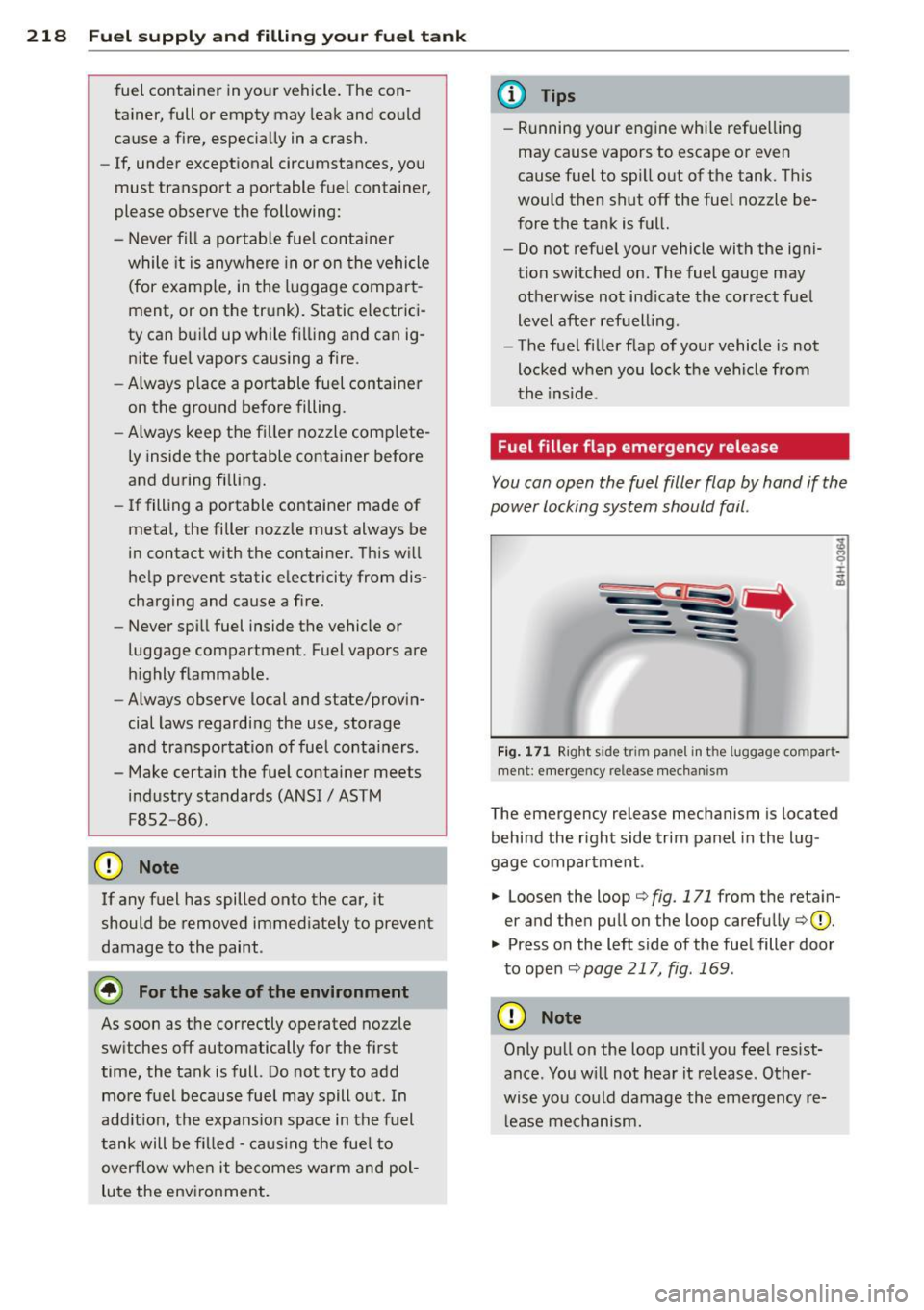
218 Fuel supply and filling your fuel tank
fuel container in your vehicle. The con
tainer, full or empty may leak and could
cause a fire, especially in a crash.
- If, under exceptional circumstances, you
must transport a portable fuel container,
please observe the following:
- Never fill a portable fuel container
while it is anywhere in or on the vehicle
(for example, in the luggage compart
ment, or on the trunk). Static electrici
ty can bui ld up while filling and can ig
nite fuel vapors causing a fire .
- Always place a portable fuel container
on the ground before filling.
- Always keep the filler nozzle complete
ly inside the portable container before
and during filling.
- If filling a portable container made of
metal, the filler nozz le must always be
in contact with the container. This will
help prevent static electricity from dis
charging and cause a fire .
- Never spill fuel inside the vehicle or
luggage compartment. Fuel vapors are
highly flammable.
- Always observe local and state/provin
cial laws regarding the use, storage
and transportation of fuel conta iners .
- Make certain the fuel container meets
industry standards (ANSI/ ASTM
F8S2 -86) .
d) Note
If any fuel has spilled onto the car, it
should be removed immediate ly to prevent
damage to the paint.
@ For the sake of the environment
As soon as the correctly operated noz zle
switches off automatically for the first
time, the tank is full. Do not try to add
more fuel because fuel may spill out. In
addition, the expansion space in the fuel
tank will be filled -causing the fuel to
overflow when it becomes warm and pol
lute the environment.
(D Tips
-Running your engine whi le refue lling
may cause vapors to escape or even
cause fuel to spi ll out of the tank. This
would then shut off the fuel nozzle be
fore the tank is full.
- Do not refuel your vehicle with the igni
tion switched on. The fuel gauge may otherwise not ind icate the correct fuel
level after refuelling .
- The fuel filler flap of your vehicle is not
locked when you lock the vehicle from
the ins ide .
Fuel filler flap emergency release
You can open the fuel filler flap by hand if the
power locking system should fail.
Fig. 171 Rig ht s ide t rim p an el in t he luggage compart·
men t: emerge ncy re le ase mechan is m
The emergency release mechanism is located
behind the right side trim panel in the lug
gage compartment .
.,. Loosen the loop
¢fig. 171 from the retain
er and then pull on the loop carefully
¢ (D.
.,. Press on the left side of the fuel filler door
to open
¢ page 217, fig . 169 .
(D Note
Only pull on the loop until you feel resist
ance . You w ill not hear it release . Other
wise you could damage the emergency re
l ease mechanism.